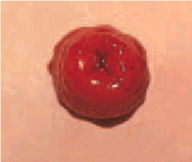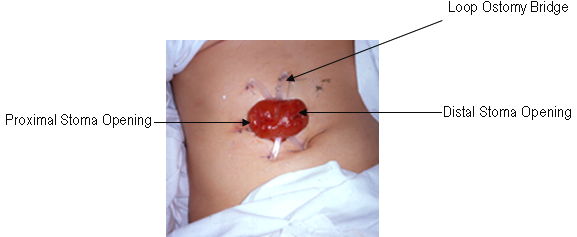
An ileostomy is an opening to the ileum, the terminal section of small intestine, which is made through the abdominal wall, and discharges digestive waste to an external collection bag (an ostomy pouch). A “loop” ileostomy is a particular type of ileostomy which is intended to be temporary (usually kept in place for only a few months to a year), and is the most common kind of ostomy that’s being created nowadays.
Temporary ostomies are often performed to divert the fecal stream from a surgery site that needs time to heal. For example, patients with rectal cancer would often, in the past, require a permanent colostomy. Now, only the very lowest rectal cancers require permanent colostomy; most of the others can be handled with “sphincter-sparing” surgeries (Bordeianou et al 2014, Ludwig 2007, McNamara & Parc 2003) which preserve continuity to the anus to allow normal defecation, but require a temporary ostomy to allow the surgery site to heal. The temporary ostomy may be a transverse colostomy (bypassing the left half of the colon) or an ileostomy (bypassing the entire colon). It’s been found that transverse colostomies suffer more complications than ileostomies; therefore, temporary ileostomies have become the preferred choice.
Temporary ileostomies are also used in construction of J-Pouches, also known as ileoanal reservoirs, and in various other situations where a portion of intestine needs to be bypassed temporarily.
An ileostomy that’s intended to be permanent will be an “end” ileostomy, also known as a standard “Brooke” ileostomy. In this case, a single cut end of ileum is pulled through the skin and made into a stoma. The resulting stoma has a reasonably round cross section, and forms a “spout” that helps keep the caustic output away from the skin. Such a stoma is relatively easy to care for.
A “loop” ileostomy is formed by pulling a loop of ileum through the skin, while it remains attached to both upstream and downstream portions of intestine beneath the skin. The resulting stoma has two openings, one from the upstream side, the other from the downstream side. The upstream opening flows digestive waste, while the downstream opening (known as a “mucous fistula”) secretes mucus that’s generated in the downstream portion of intestine.
Considering that, in every situation involving a temporary ileostomy, there is always some remaining intestine downstream from the stoma site (which hasn’t been removed but is only being bypassed), a loop stoma tends to be the natural choice. (There can be situations in which either a loop stoma or end stoma can be used for a temporary ileostomy, but even then, the loop stoma tends to be preferred because it can be closed more easily and safely when it comes time to reverse the temporary ostomy.)
Unfortunately, loop ostomies tend to be more difficult to care for than end ostomies. A loop stoma is usually shaped more irregularly, and its openings are often at skin level. Also, during the first week or two after a loop ostomy is constructed, a plastic “bridge” or rod is often kept under the stoma to prevent it from pulling under the skin.
Some photos of end and loop stomas were, some years ago, posted on a page of the C3Life website from Hollister, Incorporated. The C3Life website doesn’t exist any more, but we have preserved archived copies of the photos. First, here is a photo of an “end” stoma,

showing its typical round cross-section and single opening. Next is a photo of a loop stoma, probably a loop ileostomy:

Loop stomas have two openings, the proximal (upstream) and distal (downstream) openings, and are more irregularly shaped. Actual appearance of loop stomas can vary greatly, and one or both openings may be at skin level.
Loop ostomies are sometimes confused with “double-barrel” ostomies. Both can serve similar functions. However, a loop ostomy consists of a single stoma with two openings, while a double-barrel ostomy consists of two distinct stomas, which may be either touching each other or separated, as in the following photos:

The following photo shows a loop ostomy (in this case a transverse colostomy, based on its size and position on the abdomen), including the temporary “bridge” that may be kept in place for a week or two after construction of the loop ostomy:

You can also watch videos showing a pouch change for a new loop ileostomy (J-Pouch patient) and surgical construction of a loop ileostomy (rectal cancer patient).
If you have a temporary loop ileostomy, here are some tips that may help you deal with it:
OstomyOK Home
| What is Ostomy?
| Ostomy Care Guides
| Ostomy Supplies
| Newsletter
UOAA Discussion Board
| UOAA Support Groups
| Contact Webmaster
| Search
| Links